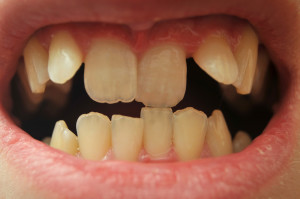 There have been many theories as to what causes crooked teeth, from ridiculous ideas such as inter-racial breeding to the consumption of soft foods. Research has even been done by examining the skulls of hunters and gatherers and comparing them with those of agriculturalists. Other research indicates that the increase in crooked teeth is nutritional in origin. Whatever the cause, three out of four children as young as five years, present with improper developing jaws and crowded teeth. Today, your Livonia, MI dentist, Dr. James Stewart talks about crooked teeth.
There have been many theories as to what causes crooked teeth, from ridiculous ideas such as inter-racial breeding to the consumption of soft foods. Research has even been done by examining the skulls of hunters and gatherers and comparing them with those of agriculturalists. Other research indicates that the increase in crooked teeth is nutritional in origin. Whatever the cause, three out of four children as young as five years, present with improper developing jaws and crowded teeth. Today, your Livonia, MI dentist, Dr. James Stewart talks about crooked teeth.
Seniors and Dental Health
 As you age you notice your body changing. You may become a bit forgetful, your muscles may become sore easier, you may be getting a few aches and pains in your joints, or find that physical activity makes you stiff the next morning. You know your body is going to age. You’ve watched your parents as their bodies began to age, your aunts and uncles, and your grandparents. However, for some reason teeth seem as if they should be ageless, but teeth age too. Today, your Livonia, MI dentist, Dr. James Stewart, talks about seniors and their dental health.
As you age you notice your body changing. You may become a bit forgetful, your muscles may become sore easier, you may be getting a few aches and pains in your joints, or find that physical activity makes you stiff the next morning. You know your body is going to age. You’ve watched your parents as their bodies began to age, your aunts and uncles, and your grandparents. However, for some reason teeth seem as if they should be ageless, but teeth age too. Today, your Livonia, MI dentist, Dr. James Stewart, talks about seniors and their dental health.
Oral Health and Heart Disease: Is There a Connection?
 It has been all over the news that your oral health can affect your overall health. It’s said that periodontal disease (gum disease) can contribute to diabetes, high blood pressure, stroke, Alzheimer’s, and heart disease. But how? In today’s blog, your Livonia, MI dentist, Dr. James Stewart, explains the oral-systemic connection between oral health and heart disease.
It has been all over the news that your oral health can affect your overall health. It’s said that periodontal disease (gum disease) can contribute to diabetes, high blood pressure, stroke, Alzheimer’s, and heart disease. But how? In today’s blog, your Livonia, MI dentist, Dr. James Stewart, explains the oral-systemic connection between oral health and heart disease.
August 2014: Hazel Park 3rd Annual Art Fair, Livonia MI
 Do you enjoy the visual and the musical? Are you an artist yourself? Do have a budding artist or musician in your family, or are you just looking for something fun and entertaining to do? Your Livonia, MI dentist, Dr. James Stewart suggests checking out the Hazel Park 3rd Annual Art Fair at Green Acres Park in Hazel Park MI. A wonderful way to spend the day or the weekend with the whole family, and best of all it’s free!
Do you enjoy the visual and the musical? Are you an artist yourself? Do have a budding artist or musician in your family, or are you just looking for something fun and entertaining to do? Your Livonia, MI dentist, Dr. James Stewart suggests checking out the Hazel Park 3rd Annual Art Fair at Green Acres Park in Hazel Park MI. A wonderful way to spend the day or the weekend with the whole family, and best of all it’s free!
Tetracycline Stains
 Are you suffering from tetracycline stains? Tetracycline is an antibiotic that has been in use for over 60 years for a variety of infections including UTI’s (urinary tract infections), intra-abdominal infections, and other degenerate bacterial infections. Tetracycline has been associated with adverse side effects including permanent staining of the teeth. One of the first reported cases of tooth staining due to tetracycline use was in 1956. Since then tetracycline is no longer prescribed to pregnant mothers in their second and third trimesters, or in children under the age of 8. However, baby boomers and older adults may have already incurred staining due to tretracyline and today there is something they can do about it. Your Livonia, MI dentist, Dr. James Stewart, discusses tetracycline stains and what you can do to get rid of them in today’s blog.
Are you suffering from tetracycline stains? Tetracycline is an antibiotic that has been in use for over 60 years for a variety of infections including UTI’s (urinary tract infections), intra-abdominal infections, and other degenerate bacterial infections. Tetracycline has been associated with adverse side effects including permanent staining of the teeth. One of the first reported cases of tooth staining due to tetracycline use was in 1956. Since then tetracycline is no longer prescribed to pregnant mothers in their second and third trimesters, or in children under the age of 8. However, baby boomers and older adults may have already incurred staining due to tretracyline and today there is something they can do about it. Your Livonia, MI dentist, Dr. James Stewart, discusses tetracycline stains and what you can do to get rid of them in today’s blog.
What Do You Know About Your Pets Teeth?
 Can your pets get cavities? Have you ever wondered? Take your Livonia, MI dentist, Dr. James Stewart’s fun, fact-filled, Friday quiz to find out what you know about your pet’s teeth.
Can your pets get cavities? Have you ever wondered? Take your Livonia, MI dentist, Dr. James Stewart’s fun, fact-filled, Friday quiz to find out what you know about your pet’s teeth.
August 2014: Explore Greenfield Village in Dearborn MI
 Are you a family of history buffs or are you just looking for something interesting and mesmerizing to do? Dearborn MI features 4 one-of-a-kind attractions including The Henry Ford Museum, Greenfield Village, a factory tour, and an IMAX. Take in all four at once, or one at a time. Your Livonia, MI dentist, Dr. James Stewart suggests starting with a day with the family learning about and exploring three centuries of American life at Greenfield Village, Dearborn MI.
Are you a family of history buffs or are you just looking for something interesting and mesmerizing to do? Dearborn MI features 4 one-of-a-kind attractions including The Henry Ford Museum, Greenfield Village, a factory tour, and an IMAX. Take in all four at once, or one at a time. Your Livonia, MI dentist, Dr. James Stewart suggests starting with a day with the family learning about and exploring three centuries of American life at Greenfield Village, Dearborn MI.
Why Extract A Tooth?
 With all the dental treatments available today, it seems the need to extract a tooth would be passé. So, why do dentists still extract teeth? Aside from wisdom teeth which often need to be extracted to prevent future problems, there are reasons dentists choose tooth extraction as the treatment of choice. Today, your Livonia, MI dentist, Dr. James Stewart discusses reasons to extract a tooth.
With all the dental treatments available today, it seems the need to extract a tooth would be passé. So, why do dentists still extract teeth? Aside from wisdom teeth which often need to be extracted to prevent future problems, there are reasons dentists choose tooth extraction as the treatment of choice. Today, your Livonia, MI dentist, Dr. James Stewart discusses reasons to extract a tooth.
August 2014: Marvins Marvelous Mechanical Museum, Farmington Hills, MI
 Do you and your kids love the wacky and the wonderful? If so, you are going to love this museum. If you are looking for something unusual and unique to do with the family, look no further. Your Livonia, MI dentist, Dr. James Stewart recommends a visit to Marvins Marvelous Mechanical Museum in Farmington Hills, MI. Read on for more info.
Do you and your kids love the wacky and the wonderful? If so, you are going to love this museum. If you are looking for something unusual and unique to do with the family, look no further. Your Livonia, MI dentist, Dr. James Stewart recommends a visit to Marvins Marvelous Mechanical Museum in Farmington Hills, MI. Read on for more info.
Oral Health Facts For Seniors
 Your bodies change as you age. You lose muscle mass, bone density, strength, balance, memory, and teeth. But, you don’t necessarily have to lose your teeth. The loss of your teeth is something you can help prevent. According to the American Dental Hygienists’ Association (ADHA), nearly 250 million people throughout the US, Japan, and Europe suffer from tooth loss. In today’s blog, your Livonia, MI dentist, Dr. James Stewart shares other important oral health facts for seniors.
Your bodies change as you age. You lose muscle mass, bone density, strength, balance, memory, and teeth. But, you don’t necessarily have to lose your teeth. The loss of your teeth is something you can help prevent. According to the American Dental Hygienists’ Association (ADHA), nearly 250 million people throughout the US, Japan, and Europe suffer from tooth loss. In today’s blog, your Livonia, MI dentist, Dr. James Stewart shares other important oral health facts for seniors.


